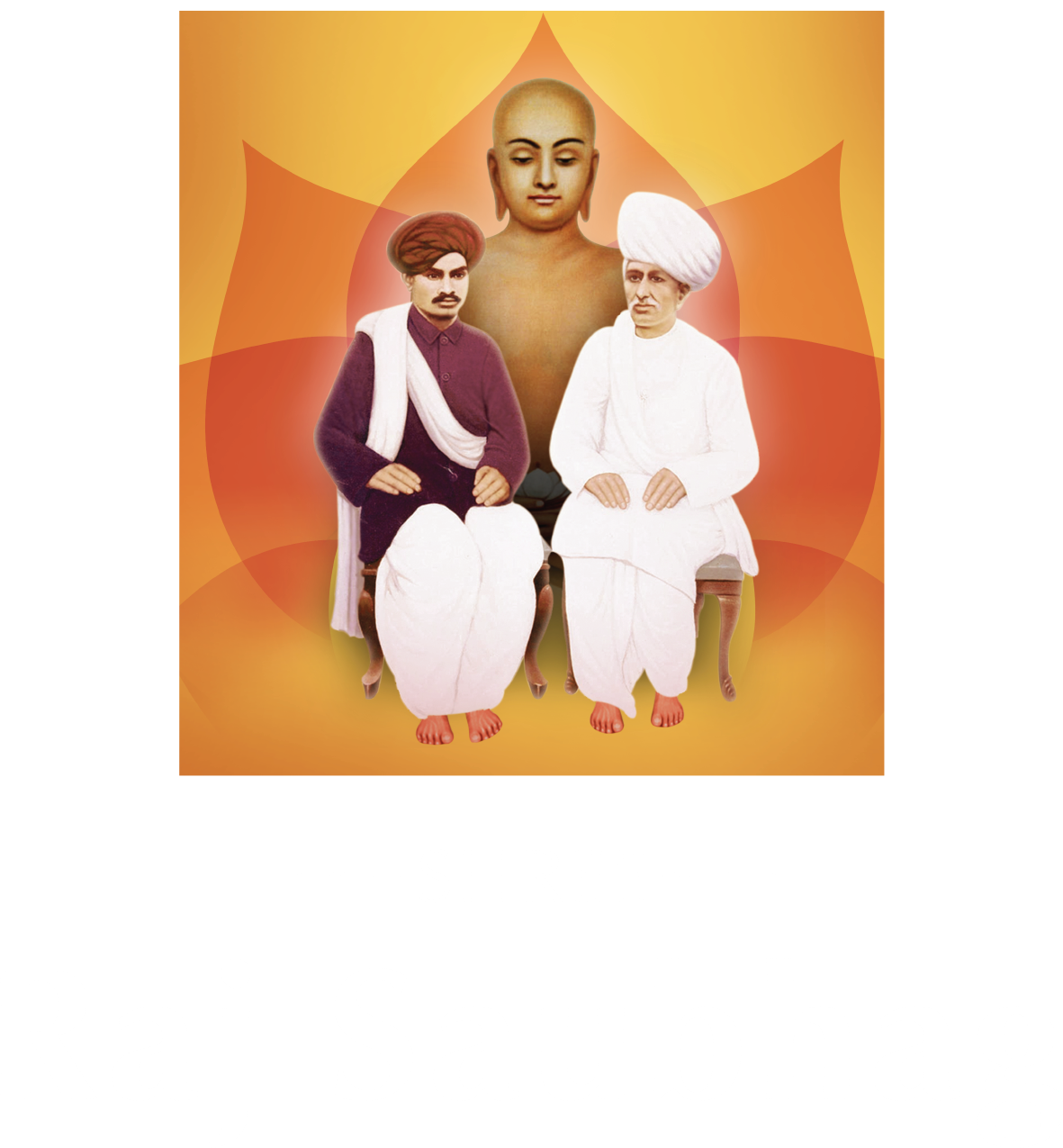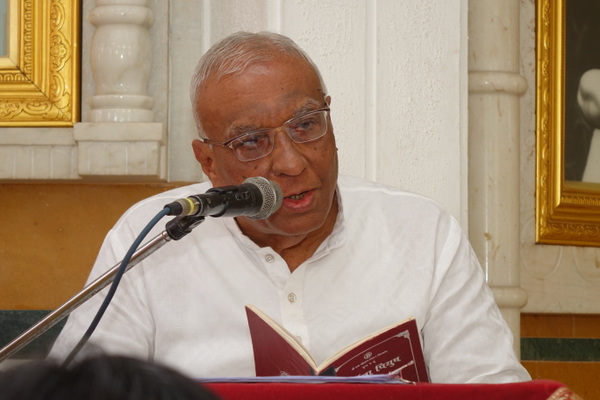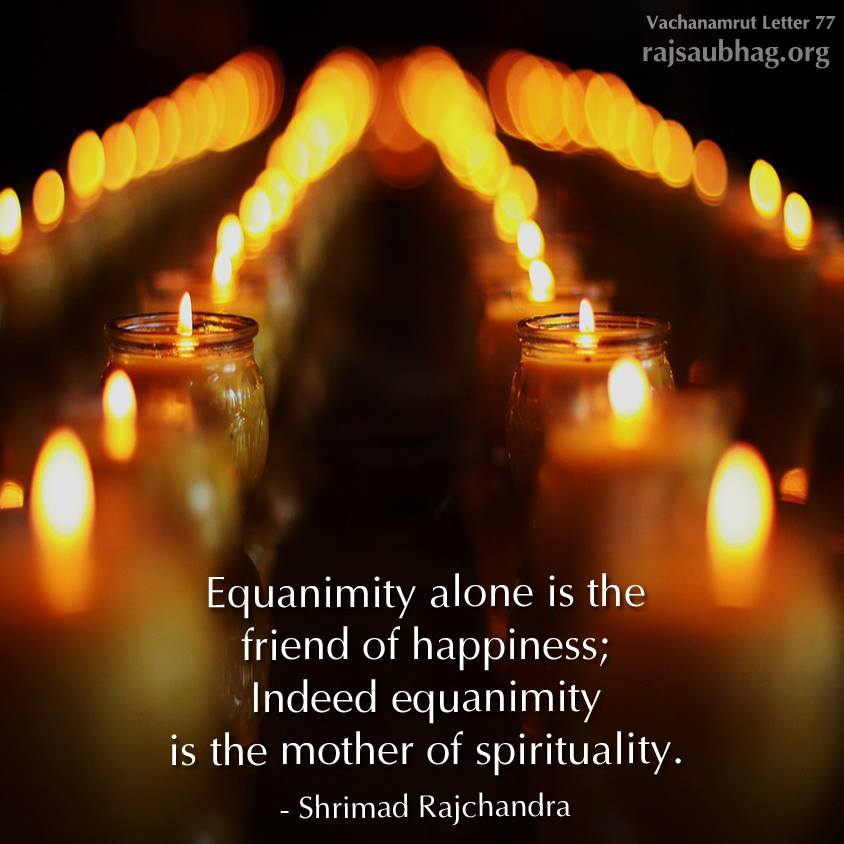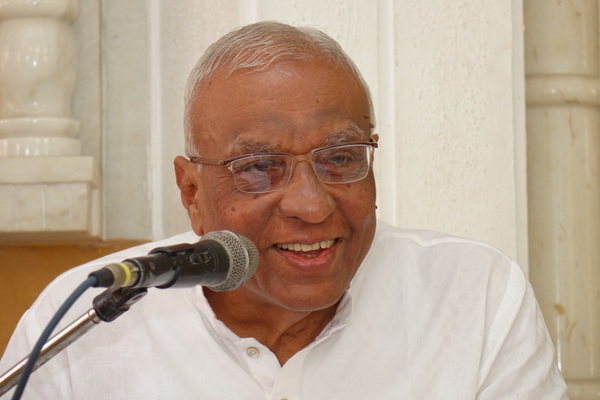Param Krupalu Dev Shrimad Rajchandra's soul left its mortal body 118 years ago on Chaitra Vad 5, VS 1957 in the city of Rajkot (India). Followers of Shrimad Rajchandra remember and honour him on this pious day in Rajkot annually. This year Chaitra Vad 5 was on April 24, 2019.
Param Pujya Bhaishree too went to Rajkot to pay his reverence to this great soul. Shrimad Rajchandra Gnan Mandir hosted a four days event where saints of different Shrimad Rajchandra Ashrams came together for spiritual discourse and bhakti.
Spiritual seekers got the benefit of two discourses of Pujya Bhaishree, one in Gnan Mandir on 23rd and the second in Samadhi Mandir on 24th April.
Bhaishree's first swadhyay on ‘mumukshu’ (true seeker of liberation)
Bhaishree started the discourse by bowing to Bhagvan Mahavir, Param Krupalu Dev and all the mumukshus. He then explained what a true mumukshu is by referring to Param Krupalu Dev's literature such as,
“જગતમાં રૂડું દેખાડવા માટે મુમુક્ષુ કંઈ આચરે નહીં, પણ રૂડું હોય તે જ આચરે.”
- Letter 274
“વિનયભક્તિ એ મુમુક્ષુઓનો ધર્મ છે.”
- Letter 925
“આજ્ઞાનું આરાધન એ જ ધર્મ છે.”
Bhaishree revealed that a worthy mumukshu is one who has developed the two virtues: discrimination (vivek) and detachment (vairagya) within.
The characteristics of a mumukshu is called mumukshuta; the main characteristic of a mumukshu is that she/he feels like being imprisoned in the body.
Bhaishree shared that Param Krupalu Dev wished that all the ignorant souls in the universe free themselves completely from all the worldly miseries. However due to false understanding worldly souls believe that they are the body (agnan). Their cycle of rebirths is going on since eternity because of this ignorance. When an ignorant soul meets an enlightened saint of Param Krupalu Dev’s calibre, listens to him and really starts believing that this world is full of miseries and strives to free itself from it. This is called mumukshuta.
Bhaishree also pointed out seven qualities of mumukshus from Shree Atmasidhhi Shashtra, verse 138:
“દયા, શાંતિ, સમતા, ક્ષમા, સત્ય, ત્યાગ, વૈરાગ્ય;
હોય મુમુક્ષુ ઘટ વિષે, એહ સદાય સુજાગ્ય.”
These virtues must be present in all spiritual seekers else they lack true quest for liberation.
With awe in his eyes Bhaishree shared that Shree Atmasidhhi Shashtra is creation of Param Krupalu Dev’s utmost compassion towards mumukshus. He also said that Shree Atmasidhhi Shashtra alone is enough for the mumukshus to succeed in the spiritual path because it encapsulates the essence of all the scriptures in 142 verses.
Referring to Shrimad’s letter number 254, Bhaishree explained three main causes obstructing progress in the spiritual path: (1) આ લોકની અલ્પ પણ સુખેચ્છા, (2) પરમ દૈન્યતાની ઓછાઈ અને (3) પદાર્થનો અનિર્ણય.
(1) Even the slightest desire for happiness from this world: This happens because one has not firmly concluded that the “truth” is undoubtedly so, or because one has not concluded that this indeed is the “very nature of ultimate bliss”. Or else, even in the quest for liberation some happiness is enjoyed, and these external circumstances feel dear (!) and because of this the slightest desire for happiness from this world remains; due to which worthiness of the soul is curbed.
(2) Lack of utmost humility, modesty and respect: Recognising that the enlightened master is the very same as the Lord, is what the enlightened ones have described as the highest dharma, and this recognition inspires the “highest form of humility” such that one has a feeling of servitude towards all living beings, and this enables the highest worthiness. To the extent that this highest form of humility is obscured, the soul’s worthiness is bounded.
(3) Inconclusiveness about one’s true nature: If one has removed both above faults but has not been able to experience the soul, their wandering mind can become restless and a false peace arises. Imaginary concepts are considered the “truth” and as a result, over time, complete devotion is not experienced for the Soul. This fault stops one from attaining the highest worthiness.
Param Krupalu Dev further stated in letter 254 that he has observed above three obstructive causes in very many seekers of liberation that have met him. He has observed a reduction of the second obstructive cause in only a few, and, if they strive to nullify it in every way then they can also remove the other two faults and become worthy to make progress in the path towards self realization.
The ultimate tool to remove fault number two is to recognise the enlightened master to be the same as the Lord (પરમેશ્વર બુદ્ધિ ) and abide by his instructions. This gives us the highest worthiness. This is possible only when one recognises the inner state of the master. Param Krupalu Dev has stated that, “મુમુક્ષુનાં નેત્રો મહાત્માને ઓળખી લે છે”.
Bhaishree adds that it is extremely difficult to recognise a Mahatma (enlightened master) unless mumukshus have developed the vision to recognise one. Lack of Mahatma’s recognition brings about many doubts in the mumukshus’ minds making it impossible to reach to Self Realisation. Therefore mumukshus must develop vision to recognise Mahatma because only a Mahatma knows the true path to Self Realisation.
Having recognised the inner state of an enlightened master, one develops unwavering faith towards the Mahatma which leads to curing of delusion and attachment, which in turn leads to conclusion on the true nature of the soul, leading to solution of doubts, birth of doubtlessness (નિઃશંકતા), which leads to becoming fearless (નિર્ભય) and ultimately experience the distinctness of soul from the body (નિઃસંગતા).
By developing and building on the qualities of a mumukshu as written by Param Krupalu Dev, a seeker can attain all milestones and achieve his/her goal. This letter contains deep meaning of the scriptures and hence Param Krupalu Dev advises mumukshus to further understand the letter by mutual contemplation.
Bhaishree concluded the swadhyay with a story about Mahatma Ved Dharm and his disciple Sandipak. At the end, Bhaishree emphasised that if one wants to succeed quickly and get rid of ignorance in this life, they will have to develop mumukshuta and ultimate devotion like Sandipak as only this will lead them to Self Realisation.
Click on the link to listen to Mahatma Ved Dharm and disciple Sandipak’s story from Bhaishree (audio and video both below):
Bhaishree's second swadhyay on the true path to Moksha
In the early morning on the pious day of Shrimad's Param Samadhi Din, in his swadhyay Pujya Bhaishree elucidated the true path to Moksha.
Bhaishree bowed to the last disciple of Mahavir Bhagwan, Shrimad Rajchandraji and also to all the souls who were fortunate to be present on this ominous day to do bhakti and swadhyay from Shrimadji’s literature, in the same place that he spent his last days and where his remains are still present.
Bhaishree talked about the power of the literature Krupalu Dev has left behind. He said that Shree Atmasidhhi Shashtra is such an amazing scripture that it alone is capable of recreating all the scriptures if they ever happened to be destroyed by a calamity.
Bhaishree said that we should strongly believe in the five affirmations (પદ) as described by Param Krupalu Dev in ‘Shri Atmasidhhi Shashtra’ without any doubt and start putting in practice the sixth affirmation that ‘મોક્ષનો ઉપાય છે’ (There is a means to Moksha). This affirmation starts from verse 97.
Bhaishree said that we do not need to look for and research the scriptures to find the means to Moksha because Param Krupalu Dev has clearly told us about it in Atmasiddhi, verse 100:
રાગ, દ્વેષ, અજ્ઞાન એ, મુખ્ય કર્મની ગ્રંથ;
થાય નિવૃત્તિ જેહથી, તે જ મોક્ષનો પંથ.
Shri Atmasiddhi Shashtra, Verse 100
Param Krupalu Dev has shared from his own experience that attachment, aversion and ignorance are the fundamental causes of karmic bondage. The path which leads to their riddance, is indeed the path to liberation.
Each mumukshu must develop an impartial ability to observe and identify his/her raag (likes) and dvesh (dislikes) at all times. It is when a mumukshu can do this effectively; s/he can start putting a stop to the dualities of likes and dislikes by staying alert and being aware of it as soon as it arises.
When a past raag or dvesh karma is triggered, due to false understanding, one feels that it is happening to oneself and mixes his/herself in the manifestation of the karm and as a result does raag bhaav or dvesh bhaav and increases the karmic bondage. Instead, at this time if the soul becomes aware of them and stays still in its inherent nature by observing equanimity and hence does not join with the past karma by not doing new raag or dvesh then no new karma is bonded and the triggered past karma gets over.
A mumukshu must practice observing equanimity in all situations, be it favourable or unfavourable. This process is also called upsham (ઉપશમ) and its success depends upon the extent of detachment towards worldly life. That is why vairagya and upsham are two fundamental qualities mumukshus must have and these qualities must keep on increasing in order to make progress in the path.
Anandghan Maharaj Saheb has said that everyone talks about religion but not everyone knows the intent of the religion. That is why Param Krupalu Dev had tried to explain the intent of religion saying, “જ્યાં ત્યાંથી રાગદ્વેષ રહિત થવું એ જ મારો ધર્મ છે.”
Raag - the main cause of attracting new karma
Bhaishree revealed that raag is the main cause of attracting new karma among other causes. To understand raag better, we must be aware of its various interpretations.
Raag means:
Attraction,
Interest,
Desire,
Enjoyment,
Merrimaking,
Indulgence,
Entertainment
To get immersed in worldly activities
Raag makes us do all these things everyday. To get attracted, give value, importance and prestige to what is not ours (પરવસ્તુ) is called raag. To have interest towards what is not ours is called raag.
There are about 35 different types of raag we do. Attraction is bigger fault than aversion and is also a cause of aversion. Raag is the father of dvesh because without raag there is no dvesh. Dvesh will not go away until raag is present in us. Hence we should distance ourselves and rise above raag.
Bhaishree then quoted Param Krupalu Dev in letter 77 that, “અધ્યાત્મની જનની તે ઉદાસીનતા”. He further explained that udasinta means to rise above worldly matters and relations and not have attachment and indulgence towards them. When we become udasin our raag becomes mild and dvesh starts fading away.
It's a common belief to not do dvesh. People normally try to get rid of dvesh because it is an obvious fault and is unpleasant but they don’t realize that raag is also a fault. Everyone says not to do dvesh but none say not to do raag. For example, no one says not to have raag towards your family members because they don’t realize that raag is bigger fault than dvesh. When our expectations are not met, it is raag towards relations and worldly matters that cause dvesh. Intensity of dvesh depends upon the intensity of raag.
Raag is subtle while dvesh is obvious. Dvesh can take one towards external violence but one can stop from being violent if s/he becomes aware of its consequences beforehand. While raag takes one all the way to internal violence (ભાવ હિંસા) without even realizing and hence one cannot stop it beforehand.
Both the doer and receiver of raag are unaware of raag’s internal violence (turmoils). Those doing dvesh repent when they become aware of it but those doing raag do not repent because they do not see any harm in doing raag.
Bhaishree said that we don’t like when the receiver of our dvesh responds with dvesh towards us but we expect the receiver of our raag to always respond with continuous raag towards us. Dvesh is like a barking dog while the raag is like the dog that “bites” us while licking our feet. We don’t like it when dvesh stays with us for a long time but we want raag to stay with us for a long time.
Raag does not always last on one thing because it is vibhaav not swabhaav (not our nature). We will eventually have to let raag go. Once raag is gone all the vices associated with it will also go such as anger, ego, deceit and greed. These four passions are always in raag’s service and make raag stronger.
Raag and false understanding (મિથ્યામતિ) support each other. The fire of unhappiness within us is ignited by raag. World’s problems are caused by raag. Raag is biased and supports wrong acts such as violence, untruth and theft etc. Raag’s partiality can be understood further if we contemplate upon daily life examples. One’s sins will be reduced if raag becomes mild. A strong person becomes meek against raag.
Some people are wise about not doing dvesh but they are all unwisely engaged in doing raag. Bhaishree says that dvesh appears worse than raag but in reality raag is more harmful than dvesh because raag attracts one towards the worldly things while dvesh can cause detachment from them as it makes us realise it's frivolousness. Thus in many ways, raag is worse than dvesh.
Bhaishree further said that one does raag towards worldly matters and the body they reside in. The latter is matter (જડ) and not ours (પરવસ્તુ). Raag towards matter results in dvesh when wants are not fulfilled. Dvesh is then followed by all four passions (Anger, Ego, Deceit and Greed). It is ignorance that attracts us towards matter. The false belief that 'I am the body’ makes one want to take ownership of things that do not belong to self. That is why it is said to stay detached from raag, dvesh and agnan when they are triggered by the past karma and stay in svabhaav because that is the path to Moksh.
There are two types of raag:
1) Praiseworthy or pious (prashast)
2) Not praiseworthy or worldly. (Aprashast)
Praiseworthy raag is towards God and enlightened saints. Such raag must be cultivated as it is healthy for a spiritual aspirant.
Bhaishree then talked about jealousy, a vice present in all ignorant souls in varying degree. He narrated a story of a person named Talakchand who eventually lost his life because of jealousy. He said that only someone who’s Darshan Moh has become mild will be able to develop virtues and build upon them.
Click on the link to listen to Talakchand’s story from Bhaishree (audio and video both available):
Bhaishree concluded by saying that true belief in Satdev, Satguru, Satdharma and Satshashtra is called vyavahar samyaktva. When one with vyavahar samyaktva gets rid of agnan by right understanding and following the path as laid down by the true enlightened master, it is called 'nischay samyaktva’ or samyak darshan (Self Realization). One generates tremendous amount of strength from within the soul (આત્મબળ) when one attains Samyak Darshan. This strength then helps one to make further progress in the marg by lessening raag and dvesh. Eventually a moment comes when one completely eliminates attraction and aversion forever. This state is called vitraagta - a state of equanimous detachment. The path that gets one here is the true means to Moksh.
Bhaishree's swadhyay in Gnan Mandir: A True Seeker of Liberation
Bhaishree's swadhyay in Samadhi Mandir: The True path to Moksh


























